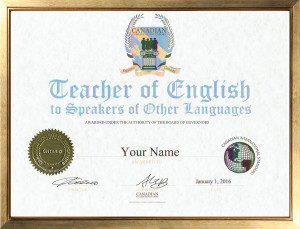For anyone not familiar with TESOL, or at least not aware of what the acronym means, it stands for “Teaching English to Speakers of Other Languages.” Other acronyms you may see alongside TESOL, including TEFL, TESL, ESL, and ESOL, which all mean about the same thing for the most part. Being a TESOL teacher has many benefits, but before you can become one, you will need to get a TESOL certification.
There are a number of different TESOL certifications and training available. The certification will provide you with an understanding of how people learn, as well as how you can help teach them. 120-hours of training is often the minimum requirement for TESOL certifications, so it’s best to choose a course with at least this many hours. The majority of TESOL jobs also provide some training. EF also offers plenty of training.

Source: Internet
THE DIFFERENCE BETWEEN TESOL AND TEFL
The most recognized qualifications for teaching English abroad to non-native speakers are TEFL and TESOL certifications. While these two certifications are quite similar, there is a technical difference between them. TEFL allows you to teach English in a non-English speaking country like Vietnam, China or Russian… TESOL, on the other hand, is a designation for teaching English to second-language speakers in an English-speaking country – study abroad students, expats, immigrants and so on. For most teaching jobs, however, these certifications are treated as equivalents.
CAREER OPPORTUNITIES
Once you receive your TESOL/TEFL certification, you will be qualified to teach ESL in a variety of ways around the world. Opportunities for teaching English range from being an English teacher to primary school students to teaching fluent professionals trying to perfect their accent in after-school classes. ESL teachers are very much in high demand throughout the world. You can create a career out of teaching English thanks to several TESOL schools offering job-placement assistance and maintaining a program and school network across several regions of the world.
TESOL TRAINING
There are two ways you can go about training for TESOL certifications: online courses and in-person courses. Both routes typically require a minimum of 120-hours to receive the certification. Although, there are some notable differences between them.
IN-PERSON TESOL CERTIFICATIONS
One benefit of getting certified in a class is the chance to gain experience within a classroom setting. You will learn and communicate in person, as well as gain valuable experience teaching in front of a class. This type of TESOL training can help you become more comfortable working with students.
ONLINE TESOL CERTIFICATIONS
The biggest draw of online training is its practicality. With online courses, you can complete the training anytime from anywhere. This type of TESOL course is also generally much more affordable than training within a classroom setting.
TESOL CERTIFICATION COSTS
While online training is the more affordable option, training for TESOL certifications can still cost you quite a bit of money. In-person classes can cost up to a few thousand dollars, with online options costing up to several hundred. There’s a large variety in the affordability of these courses, so it’s important to do your research. There are some companies, EF English First included, offer to sponsor your TESOL certification if you meet specific requirements.
BENEFITS OF TESOL CERTIFICATIONS
The English language has become widely spoken throughout the world nowadays, making native English-speaking teachers very high in demand. Being TESOL certified can open all kinds of doors for you to see the world, experience other cultures, and promote cultural exchange. As you teach in another country, you’ll also be learning things yourself about these countries, their culture, and more.
